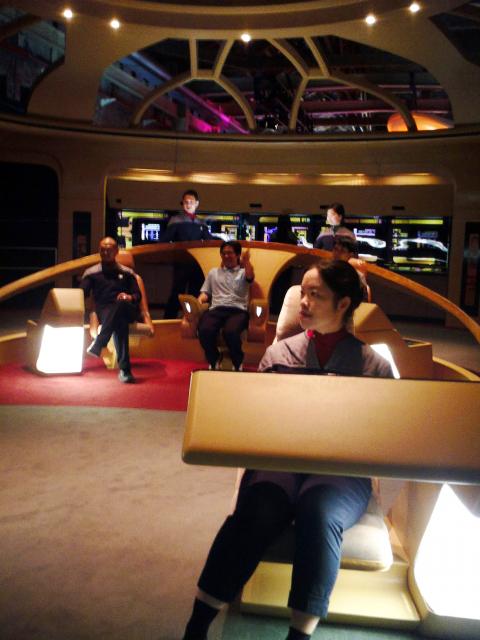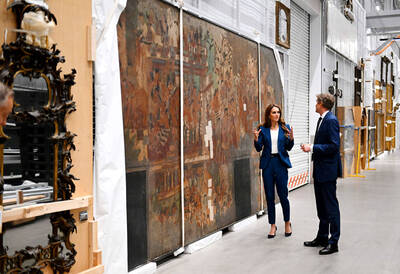When J. J. Abrams’ long-awaited Star Trek Into Darkness opened in May, salivating Taiwanese nerds bounded to the theaters and got to see that the villain was Kahn all along, six days before the film’s US release. For local trekkies already worried about finding the next fix, never fear. There’s a new opportunity in town to spend money on the Star Trek brand: the Star Trek exhibition at Huashan 1914 Creative Park.
But while Abram’s Star Trek films have resuscitated a dying franchise, Star Trek: The Exhibition is more like an autopsy. Those new to Star Trek or only acquainted with the recent films will be lost. Structured like a haphazard Star Trek history museum, the exhibition does little to generate any excitement about the long-running series and movies, and instead presents itself as a cheap sideshow of mostly props and broken sci-fi antiques.
The exhibition is actually a smaller version of a previous showcase called Star Trek: The Tour, which was split into two for-profit exhibits after financial problems hampered the original Tour.

Photo: James T. Hong
After paying for tickets at a makeshift ticket booth, visitors enter a darkened building and are warned about taking pictures or bringing in baby strollers. Old posters from the TV series and movies grace the first wall, and one is even reminded that Paramount actually produced the execrable Star Trek V: The Final Frontier in which Captain Kirk asks, “What does God need with a starship?”
At first glance, some of the decor looks like it could have been taken from the Las Vegas Star Trek: The Experience show. On closer inspection, however, the paneling and beams reveal themselves as cheap and flimsy. Many, if not most, of the informational panels are printed on poster board with the technique of a local copy center, in a head-scratching contrast to the futuristic backlit panels promised in the publicity photos.
Perhaps it was just too expensive to produce new plastic panels in English and Chinese for the parallel universe of Taiwan.

Photo: James T. Hong
Visitors stroll past obscure art from obscure episodes of Deep Space Nine, seemingly original TV scripts from the various series, scratched-up Klingon chairs, miscellaneous Trek gadgets, a few masks and a Ferengi butthead in all its glory. Even less interesting are displays of various costumes supposedly worn by real cast members, such as Spock’s “bath” robe from Star Trek III: The Search for Spock.
The biggest treat is a Next Generation bridge replica, where visitors can sit and have pictures taken of them for extra money. But even here the control panels are scratched, the video projection of the Earth on the view screen is dim and some of the paint has peeled. For those of us who remember when Star Trek: The Next Generation was perhaps the only English program on late-night television, this bridge does have a certain nostalgic appeal.
The exhibition ends abruptly with a gift shop, where visitors will probably spend most of their time and money. Pictures taken on a bridge replica, a fake transporter platform or a dilapidated “captain’s chair” cost a steep NT$300. Here you can also buy toy phasers, patches and — in a curious twist — some schlocky pins of astrological signs. At the exit, a large worn poster of classic Spock giving the Vulcan salute is captioned by one word: LIVE. Sure, this Star Trek exhibition lives, but it doesn’t seem to be prospering, and compared to the new Star Trek movies, it’s a sad alternate universe where Star Trek memorabilia goes to die.

June 9 to June 15 A photo of two men riding trendy high-wheel Penny-Farthing bicycles past a Qing Dynasty gate aptly captures the essence of Taipei in 1897 — a newly colonized city on the cusp of great change. The Japanese began making significant modifications to the cityscape in 1899, tearing down Qing-era structures, widening boulevards and installing Western-style infrastructure and buildings. The photographer, Minosuke Imamura, only spent a year in Taiwan as a cartographer for the governor-general’s office, but he left behind a treasure trove of 130 images showing life at the onset of Japanese rule, spanning July 1897 to

One of the most important gripes that Taiwanese have about the Democratic Progressive Party (DPP) is that it has failed to deliver concretely on higher wages, housing prices and other bread-and-butter issues. The parallel complaint is that the DPP cares only about glamor issues, such as removing markers of Chinese Nationalist Party (KMT) colonialism by renaming them, or what the KMT codes as “de-Sinification.” Once again, as a critical election looms, the DPP is presenting evidence for that charge. The KMT was quick to jump on the recent proposal of the Ministry of the Interior (MOI) to rename roads that symbolize

On the evening of June 1, Control Yuan Secretary-General Lee Chun-yi (李俊俋) apologized and resigned in disgrace. His crime was instructing his driver to use a Control Yuan vehicle to transport his dog to a pet grooming salon. The Control Yuan is the government branch that investigates, audits and impeaches government officials for, among other things, misuse of government funds, so his misuse of a government vehicle was highly inappropriate. If this story were told to anyone living in the golden era of swaggering gangsters, flashy nouveau riche businessmen, and corrupt “black gold” politics of the 1980s and 1990s, they would have laughed.

Imagine being able to visit a museum and examine up close thousand-year-old pottery, revel alone in jewelry from centuries past, or peer inside a Versace bag. Now London’s V&A has launched a revolutionary new exhibition space, where visitors can choose from some 250,000 objects, order something they want to spend time looking at and have it delivered to a room for a private viewing. Most museums have thousands of precious and historic items hidden away in their stores, which the public never gets to see or enjoy. But the V&A Storehouse, which opened on May 31 in a converted warehouse, has come up